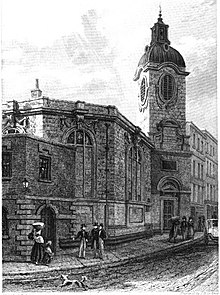St. Benet Finck
| St. Benet Fink | |
|---|---|
 |
|
| Location | London |
| Country | United Kingdom |
| Denomination | Anglican |
| Architecture | |
| Architect(s) | Christopher Wren |
| Style | Baroque |
| Demolished | 1846 |
St. Benet Fink was a church and parish in the City of London located on what is now Threadneedle Street. Recorded since the 13th century, the church was destroyed in the Great Fire of London of 1666, then rebuilt to the designs of Sir Christopher Wren. The Wren church was demolished between 1841 and 1846.
‘St. Benet’ is short for ‘St. Benedict’. There were four churches with this dedication in London before the Great Fire of 1666. The earliest surviving reference to the church is in a document of 1216, although the discovery of a 10th-century wheel-headed cross in its former churchyard suggests a Saxon foundation. In the case of St. Benet, it is certain that the Benedict referred to Benedict Biscop the 7th century Anglo-Saxon founder of Jarrow Priory, and St. Benedict Fink referred to St. Benedict of Nursia, the 6th century founder of Western monasticism. "Fink", according to John Stow, is derived from Robert Fink (alias Finch), a 13th-century benefactor who paid to have the church rebuilt. Finch Lane (originally being named as “Fink” or “Finck” Lane), off Threadneedle Street, was named after the same family.
The most significant event in the pre-Fire church was the marriage there, on 24 September 1662, of the Puritan divine Richard Baxter.
St. Benet Fink was one of 89 churches destroyed in the Great Fire. Rebuilding began comparatively quickly, in 1670, thanks partly to a donation of £1000 by George Holman, a Roman Catholic. In gratitude, he was given two pews and a place in the vault. Building of the church and steeple was completed in 1675 at a total cost of £4129.
The parish registers record the death of the church warden, Thomas Sharrow, in 1673, from falling in a vault in Paternoster Row and lying there undiscovered for 11 days. The register entry includes the admonition "Let all who read this take heed of drink".
On 9 April 1801, John Henry Newman, the future cardinal, was baptised in St. Benet Fink.
In 1838, the Royal Exchange, which had also been rebuilt after the Great Fire, burnt down. In order to improve the site of the Exchange, the Corporation of London petitioned Parliament for permission to demolish the tower of St. Benet Fink and appropriate its churchyard, as well as demolish the nearby St Bartholomew-by-the-Exchange. More than twenty City churches were to be demolished over the next century but in 1840 the demolition was enough of a novelty to elicit protests from Edward John Carlos in The Gentleman's Magazine, and from the parish. The Bishop of London, however, supported the Corporation as there were many other churches in the immediate neighbourhood.
...
Wikipedia
